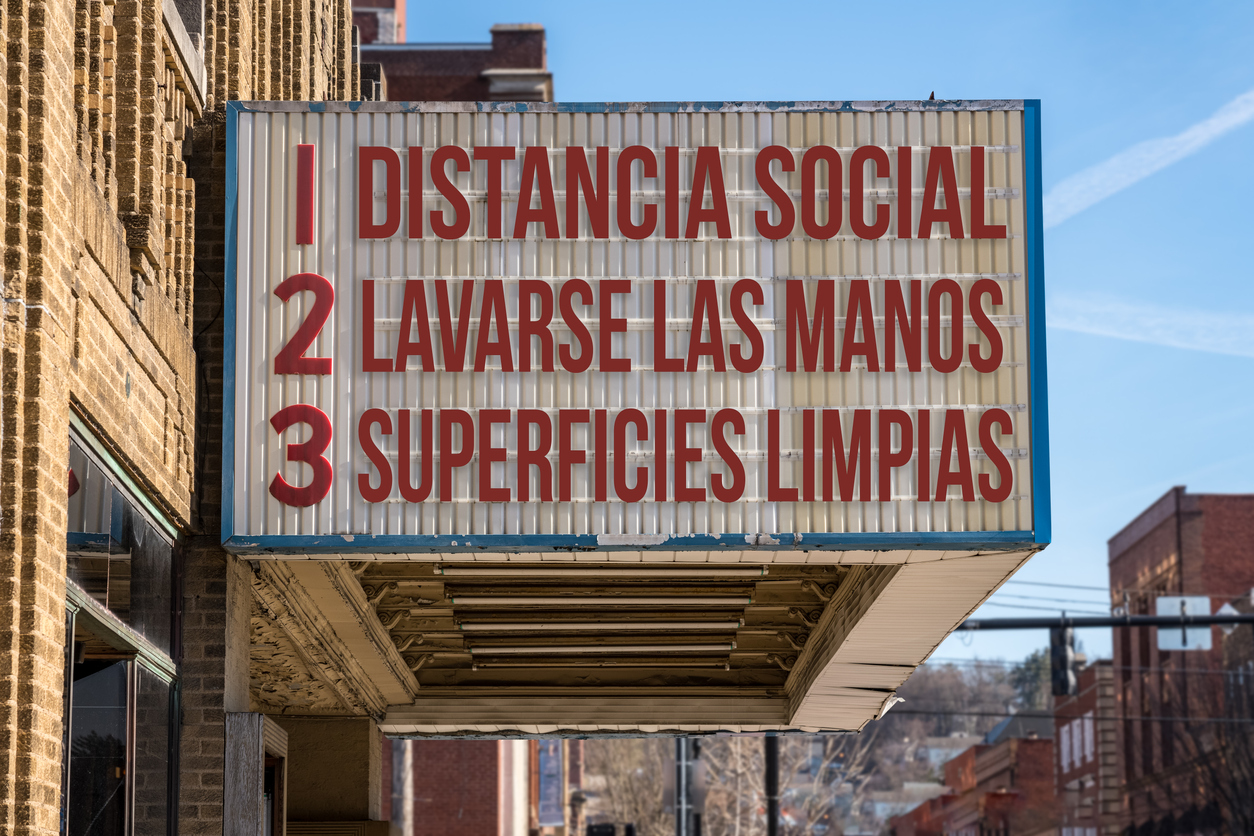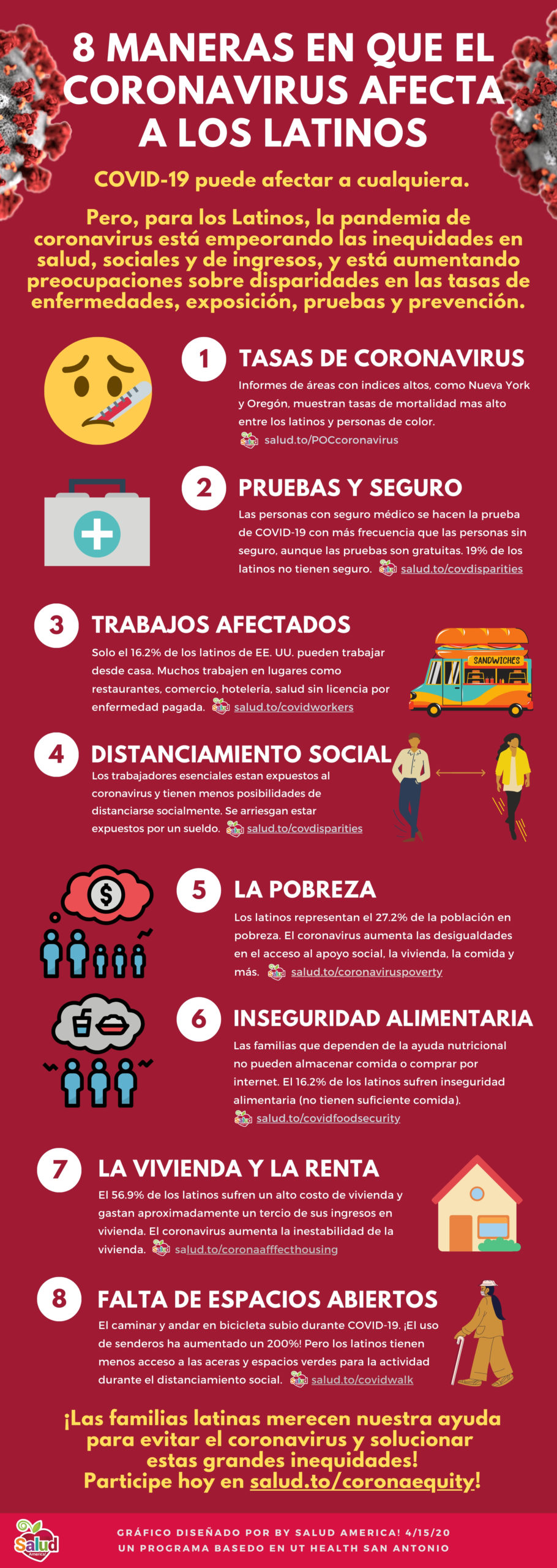
Share On Social!
U.S. Latinos are bearing an extraordinary burden of COVID-19 cases and deaths.
Why is this?
Health experts are trying to find an answer.
They say the pandemic is worsening historical health and social inequities among Latinos and other people of color, affecting people of a certain age, and those who have diabetes, obesity, and cancer, as well as those who smoke.
Now a study points to a new, but common, culprit: language barriers (and the healthcare system’s failure to accommodate people who don’t speak English).
Latinos Face Language Barriers During COVID-19 Pandemic
Language is a common barrier to health care.
That’s why Spanish translation is important in education, providing medical care, bullying prevention, healthcare access, and even podcasting.
When it comes to COVID-19, health experts say language barriers can leave vulnerable populations unaware of critical health information. They may lack knowledge of how the virus spreads, where to receive free testing, different tests being offered, and when to see a doctor. Some Latinos are stuck at home with no help.
A recent study in Annals of Epidemiology suggests that COVID-19 risks and deaths among Latino populations differ by region. They found that monolingual Spanish speakers are at elevated risk for COVID-19 acquisition.
 The study compared predictors of COVID-19 cases and deaths between disproportionally Latino counties, where Latino population is greater than 17.8% through May 11, 2020.
The study compared predictors of COVID-19 cases and deaths between disproportionally Latino counties, where Latino population is greater than 17.8% through May 11, 2020.
The study found that COVID-19 diagnoses were associated with counties with greater monolingual Spanish speakers, employment rates, heart disease deaths, less social distancing, and days since the first reported case.
The study also emphasizes that occupational exposure plays a vital role in Latino COVID-19 cases and deaths. Timely assessments and interventions for infection control and prevention can address the intersection of occupational risk and employment in some Latino communities.
“These findings serve as a call for multi-level structural interventions to address inequities in our Latino communities in response to the COVID-19 pandemic,” said study author Carlos Rodriguez-Diaz of George Washington University – Milken Institute School of Public Health.
Another recent study of severity of COVID-19 in Latinos also revealed that limited English proficiency is an important factor that influences access to care.
Researchers found that Latinos have 1.5-times worse lung infection than their white peers.
“When we were first learning how the disease spreads, there was all this rapidly evolving information coming out that was not available in languages other than English, and that lag in availability of actionable health information for non-English speaking individuals was really critical for many patients trying to navigate a complex medical system with a disease from a virus that is so aggressive,” said Dr. Efren J. Flores of Massachusetts General Hospital, in a press release.
These studies highlight the need Spanish-language information on all aspects of COVID-19.
How Cities, States Are (or Aren’t) Pushing COVID-19 Information in Spanish
Many cities and states are sharing local bilingual information about COVID-19.
On July 1, 2020, the North Carolina Department of Health and Human Services launched new online tools to help Spanish-speakers with COVID-19 testing and positive results.
The Tennessee Department of Health also has launched COVID-19 materials and resources for Spanish-speakers.

But other regions are more hit and miss.
Houston (44.8% Latino) launched a 21-Day Emergency Outreach program, “Better Together” (Todos Juntos Mejor), to share free testing sites and where to get aid. They also have a four-language COVID-19 hotline that gets 12,000 calls a day, according to the Houston Chronicle.
A large Houston hospital has even done marketing campaigns on Spanish-language TV and radio, and through grocery stores, churches, and the Houston Texans and Astros.
Yet the State of Texas hasn’t done as much translation.
“Gov. Greg Abbott’s office releases COVID-19 information through a resource website that fails to adequately translate the information into Spanish, the Texas Tribune reported. Abbott’s office does not offer translated versions of press conferences or news releases,” according to the Chronicle. “Health experts say these language barriers can leave some of the most vulnerable populations unaware of critical health information such as where to receive free testing, how the virus spreads, the different tests being offered and when to see a doctor.”
In Ventura County, Calif. (43.2% Latino), COVID-19 is spiking in the farmworker population.
So local health leaders are distributing surgical masks to farm sites, advertising in Spanish-language media, using WhatsApp to share emergency messages, and creating educational videos in Spanish and the native Mixteco language, according to the Camarillo Acorn.
“We’re doing everything we can to make sure farmworkers across the county are getting the information they need to stay safe and prevent the transmission of COVID-19,” local agricultural commissioner Ed Williams said, the Acorn reports.
Find COVID-19 Information in Spanish
Many new resources are popping up in Spanish to reduce language disparities among Latinos in amid coronavirus outbreak.
 The CDC’s Spanish-language website has lots of information. They cover how COVID-19 spreads, symptoms, prevention, treatment, travel, and more. CDC also has a Spanish-language video series with some coronavirus graphics.
The CDC’s Spanish-language website has lots of information. They cover how COVID-19 spreads, symptoms, prevention, treatment, travel, and more. CDC also has a Spanish-language video series with some coronavirus graphics.
Check out our bilingual infographic and the bilingual La Loteria COVID-19 Bingo game!
Also check out these 19 solutions to immediately ease the coronavirus pandemic and its impact on Latinos and people of color, as well as make long-term strides to address underlying inequities that are aggravated during this time.
Learn more about the coronavirus pandemic and Latino health:
Explore More:
Healthcare AccessBy The Numbers
142
Percent
Expected rise in Latino cancer cases in coming years



